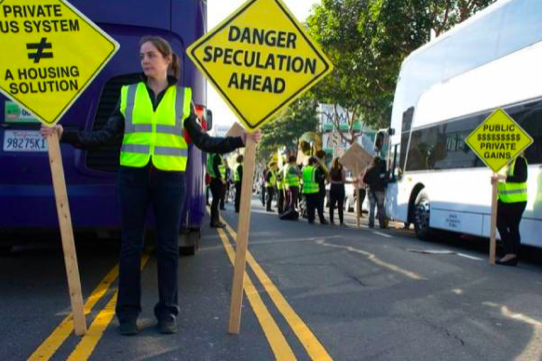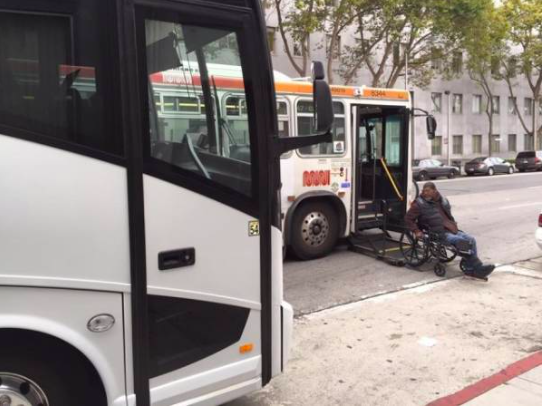
The SFMTA Board of Directors will hold a special meeting Tuesday/30 to consider, among other items, the creation of temporary emergency transit lanes. We need to tell the board that those lanes should be reserved for public transit buses only—no private buses should be allowed to operate in those lanes. No tech shuttles, no Academy of Art buses, no casino or tour buses. Muni, Golden Gate Transit, and SamTrans only.
The temporary emergency transit lanes — near School of the Arts High School, on Presidio Avenue, Masonic, 7th and 8th streets, among other places — would expire 120 days after the official end of the current shelter-in-place order. They are intended to improve Muni transit times, as fewer buses are running, but other traffic is beginning to increase.

I guess the SFMTA is operating under the assumption that some day, normal life will return — there will be a vaccine, treatment, and/or testing and contact tracing will be significantly expanded. And anyway, it’s just great that the SFMTA wants to set aside more street space for transit, pedestrians, and bicyclists.
But past SFMTA practice indicates that the SFMTA may open up these TETLs to private buses.
At the March 5, 2020 meeting of the MTA Community Advisory Committee, there was a presentation of the proposed Muni Service Equity Strategy. (As a recipient of federal funds, Muni is required to serve all demographics equitably.) Part of the proposal is the implementation of transit-only red lanes on Folsom Street.
However, in response to a subsequent Request for Information (search for RFI # 200305.03), the agency revealed it intends to allow any vehicle that fits the state definition of a bus to operate in these transit-only lanes. Such vehicles would include unlimited numbers of tech shuttle buses, casino buses, Academy of Art buses, and tour buses, among others. (For example, Chariot may have gone out of business, but Uber is testing buses and minibuses in other parts of the world and no doubt is eager to introduce its buses into San Francisco, where money is to be made if sufficient numbers of people can be lured off of public transportation. Competition with public transportation figures big in Uber’s IPO.)
This decision to let private, for-profit buses operate in transit-only lanes is confounding. Such a policy violates both state and local law and defeats the purpose of “equity” — if the point is to provide better service to disadvantaged communities.

It’s doubly confounding that the SFMTA plans to adopt this policy without conducting an environmental impact study. (As you may recall, in the summer of 2018, the SFMTA board moved forward with plans to create transit-only red lanes on Geary between Gough and Stanyan that would not, in fact, be transit-only, and also without an environmental impact report.) It’s also perplexing because it appears to ignore state and local law.
The state definition of a “bus” applies to vehicles that carry 15 or more persons, including the driver. The state definition of a transit bus applies to buses owned by or operated on behalf of a public transit agency and used to carry members of the general public. So while a “transit bus” could fit the definition of a “bus,” not all buses fit the definition of a transit bus.
Our city charter’s Transit-First Policy specifically mentions the creation of transit-only lanes as lanes for the benefit of public transit: “Transit-priority improvements, such as designated transit lanes and streets and improved signalization, shall be made to expedite the movement of public transit vehicles (including taxis and vanpools) and to improve pedestrian safety.” (Here is the state definition of a vanpool: “A ‘vanpool vehicle’ is any motor vehicle, other than a motortruck or truck tractor, designed for carrying more than 10 but not more than 15 persons including the driver, which is maintained and used primarily for the nonprofit work-related transportation of adults for the purposes of ridesharing.”)
Local Transit-Only Lanes Law
In fact, the San Francisco Board of Supervisors, using its powers under Division I of the San Francisco Transportation Code, passed an ordinance in 2008 making it an infraction for any but public transit vehicles to operate in transit-only lanes (with reasonable exceptions for turns and pulling into and out of parking spaces):
SEC. 7.2.72. DRIVING IN TRANSIT-ONLY AREA. To operate a vehicle or any portion of a vehicle within the area of any street designated in Division II as a transit-only area, except that public transit vehicles and taxicabs, vehicles preparing to make a turn, and vehicles entering into or exiting from a stopped position at the curb may be driven within a transit-only area. (31, 31.2)*(Amended by Ord. 287-08, File No. 081340, App. 12/5/2008)
And here’s another kicker: apparently in 2016, the state legislature passed a law to address the issue of transit-only lanes, and it’s specific:
“(a) A person shall not operate a motor vehicle on a portion of a highway that has been designated for the exclusive use of public transit buses, except in compliance with the directions of a peace officer or official traffic control device.”
I learned this from an AC Transit attorney when I was investigating what vehicles AC Transit intends to permit to operate in its bus rapid transit lanes in Alameda County — only public transit vehicles, it turns out.
So why has the SFMTA pursued policies that permit private, for-profit buses to violate state law and local ordinance? I’m guessing it’s because transit-only red lanes are valuable enterprise zones. Private bus providers operating on behalf of tech corporations serving Silicon Valley (Bauer’s, WeDriveU, etc.) and Bishop Ranch Industrial Park in San Ramon, among others, want access to them, and pressure has been applied to agency staff and members of the SFMTA Board of Directors to get them to adopt this policy.
The SFMTA board adopted the Muni Service Equity Strategy in early April, but it hasn’t yet legislated the creation of transit-only red lanes on Folsom Street. I can tell by examining Section 601 of Division II of the San Francisco Transportation Code and scrolling down to “(32) Other Transit-Only Areas”. In this section you can see that the SFMTA Board of Directors has legislated the creation of traffic lanes in various parts of the city that are subject to Section 7.2.72 transit-only lane enforcement (passed by the Board of Supervisors in 2008) but strangely open to “buses.”
I don’t know when the Folsom Street red lane item will be heard at the SFMTA board, but we do know that the intends to take up the creation of temporary transit-lanes on June 30. Although commuter shuttle bus operations have been suspended during shelter-in-place, we should make sure the directors know that we want these new temporary transit-only lanes to be for the exclusive use of public transit vehicles anyway. In San Francisco those would be Muni buses, Golden Gate Transit buses, SamTrans buses, and taxis. (Paratransit is not included in the state definition of a public transit vehicle.)
The agency has pursued other policies that ignore the law. It is a violation of the California Vehicle Code (22500.i) for the tech shuttle buses to operate in public bus stops. The agency also allowed the now defunct Chariot to create pick up and drop off locations without the passage of ordinances, as required by state law (22500.e.1). These policy decisions were also made without any honest public discussion or environmental impact reports.
There is much speculation as to the fate of public transportation in the nation and the world. Even if we effectively contain COVID-19, many are wondering if people will ever return to “going to work” in large enough numbers to justify the maintenance of mass public transportation. Could vast sectors of the economy be relocated from office parks to homes? That could be, but other sectors will still be about going to work: manufacturing, distribution, elementary and secondary education, most aspects of higher education, and most aspects of health care, among other sectors of the economy.
We are still going to need mass transit, though it may need a two- or three-year federal government lifeline to get through the pandemic. By then, I hope we will have a vaccine; effective and widely available treatments; and/or significantly expanded testing and contact tracing. Let’s plan for all these — and do it right.
The board meeting starts at 1pm. You can watch it live at sfgovtv. You can send comments to the Board of Directors at MTABoard@sfmta.com You could also CC the mayor at MayorLondonBreed@sfgov.org, and members of the Board of Supervisors at board.of.supervisors@sfgov.org. If you want to participate remotely in the meeting, here are the instructions.

